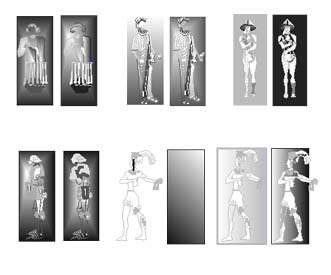

Aegean, Late Minoan from Cnossos.
[Candia Museum.] Stucco Relief . . . . In kilts falling in a weighted point, from which hangs a triangle of blue-beaded network, finished with lilies and papyrus flowers. . . . Crown [on forelock and frontal curls], with Lycian plumes, and collar combine thewas lily, [papyrus] of the Nile Delta, with the iris of Crete, in blue and henna red, which in these frescos are equivalent to silver and gold. [Forelock and frontal curls] Blue roll above red and white belt. Blue Mycenaean loin cloth of modesty, worn with a white apron, lined in red, which has been reduced to a flap behind--Ridged lines on the right thigh indicate a tiered white sash, related to the tiered skirts of snake-goddesses. Like the silver anklets shown on Oriental figures of antiquity, bracelets and necklaces indicate rank.
Cypriot c. 500 B.C.
Bearded priest or votary, with bird and incense box--in pleated, ungirdled chiton [garment of Oriental derivation] and himation.
The Knight of XVc. c. 1460. Italian.
[Metropolitan Museum.] Gothic--the body, in a globose breastplate, is now well sheathed in plate . . . . Deep skirt of many bands; wide-cuffed mitten gauntlets; salade; lengthening sollerets.
The Capistsrano of Prehistoric Italy VIc. B.C., from Abruzzi.
[Rome M. delle Terme.] The patterned garments and cuffed shoes of the relief show Etruscan influence, and the plumed headress may be compared to Priest-king of Cnossos. The Italiotic helmet of the Hallstatt Bronze period shows one form of combination of the age-old motifs of a standing ridge on the crown of a helmet, and projecting ridges specifically designed for the insertion of plumes; in their infinite permutations between Xc. B.C. and the casques of the Gallic legion, can be studied in Léon Coutil: Les Casques Proto-Etrusques, Etrusques et Gaulois, W. Sifter, Gand, 1914; and Franz Freiherr von Lipperheide: Antike helme, and are utterly fasciinating. [The Capistrano warrior's wasp-waist, apron, collar and bracelets, and dagger belted at the breast, can be seen in the Aegean/Minoan Crete and Prehistoric Sardinia.]
Copyright, 2000